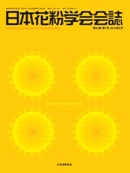All issues

Volume 69 (2023 - 202・・・
- Issue 2 Pages 41-
- Issue 1 Pages 1-
Volume 69, Issue 1
Displaying 1-3 of 3 articles from this issue
- |<
- <
- 1
- >
- >|
-
Reiko KISHIKAWA, Chie OSHIKAWA, Eiko KOTO, Akemi SAITO, Norio SAHASHI, ...2023Volume 69Issue 1 Pages 6911-
Published: August 31, 2023
Released on J-STAGE: September 26, 2024
JOURNAL FREE ACCESSIn Japan, the number of people with Japanese cedar (JC) pollinosis has increased since the 1970s. We have detected allergenic airborne pollen grains since 1987, when the govern- ment started to investigate JC pollinosis for treatment and prevention. We have studied im- portant allergenic pollen grains, Cupressaceae (JC and the Cypress family), and their cor- relations with climatic factors, for about 30 years at nine locations. Pollen grains are collected by the gravitational method. They are counted, classified, and summarized every year. From 1987 to 2021 (at latest), we have analyzed annual pollen grains counts with ref- erence to the meteorological conditions near the nine monitoring locations. Cupressaceae pollen counts have marked annual fluctuations and increase. They have a significant positive correlation with climatic conditions when the male flower buds are formed, the pollination starting days in the North regions have become earlier, and they have a negative correlation with February mean temperature. Over the 30-year period, pollen grains counts have mostly increased. The pollination season has gradually come to start at the same time throughout Japan because of the earlier start of the season in northern Japan, as a result of climate change, particularly the rise in temperature. We consider that one of reason for the increase of JC pollinosis is that climate change may be affecting Cupressaceae pollen grains counts, with counts increasing in the areas of conifer-forest with trees older than 30 years with an- other reason being the earlier start of the JC pollen season in the north of Japan.View full abstractDownload PDF (1081K) -
[in Japanese]2023Volume 69Issue 1 Pages 69113-
Published: August 31, 2023
Released on J-STAGE: September 26, 2024
JOURNAL FREE ACCESSProgress of the pollen fronts of Cryptomeria japonica and Chamecyparis obtusa in 2023 were monitored by tracking the first day of pollen release from these species using a Durham sampler at 80 sites between yushu and Hokkaido in Japan. The results showed that by early February, the C. japonica pollen front had passed through northern yushu, parts of western Chugoku and Shikoku, southern parts of inki, Tokai and small areas of southern anto and southern Tohoku. By mid-February, it had passed through southern yushu, central Chugoku, eastern Shikoku, inki, central Chubu and anto. By late February, it had reached parts of Chugoku that faced the Sea of Japan, and parts of southern to northern Tohoku. By early March, it had reached northern Tohoku, although the front had already reached parts of this area in late February, and it finally reached the western parts of Hokkaido in mid-March. The C. obtusa pollen front was first observed in mid-February in southern parts of inki. By late February, it had reached parts of western Chugoku and southern anto. By early March, it had passed through northern yushu, Chugoku, inki and anto. By mid- March, it had passed through southern yushu, Chugoku, Shikoku, inki, Hokuriku, Tokai, Chubu and Tohoku. By late March, it had reached central of northern Tohoku. By early April, it had reached the western parts of Hokkaido. Finally, the front returned to northern Tohoku and settled into a narrow area in mid-April.View full abstractDownload PDF (1916K) -
Palynological Society of Japan2023Volume 69Issue 1 Pages 1-39
Published: August 31, 2023
Released on J-STAGE: September 18, 2023
JOURNAL RESTRICTED ACCESSDownload PDF (2473K)
- |<
- <
- 1
- >
- >|